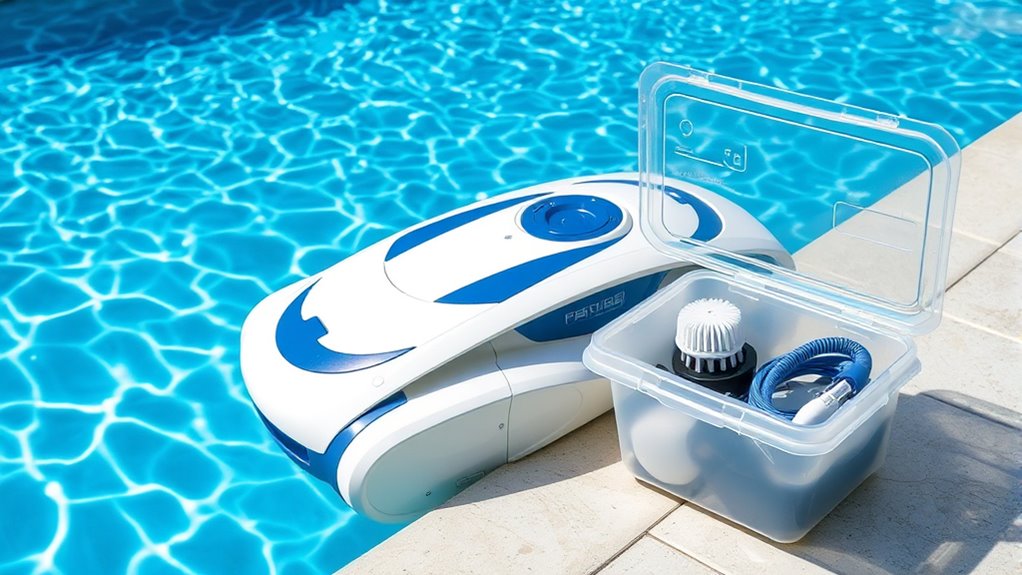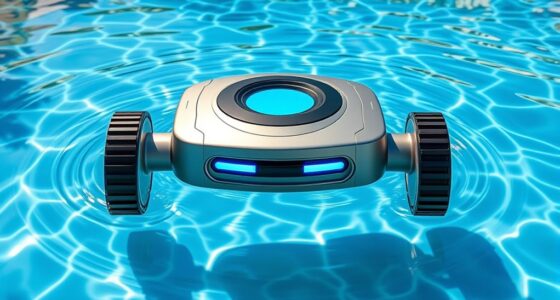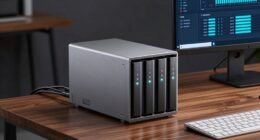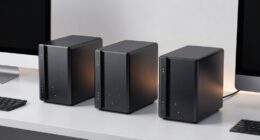To clean and store your robotic pool cleaner properly, start by removing the filter after each use and rinsing it thoroughly to remove dirt and debris. Check for damage and clean the filter housing as needed. Rinse the entire unit with fresh water, wipe it dry, and store it in a cool, shaded place away from extreme temperatures. Keep the charging station clean and inspect all components regularly to guarantee longevity; more tips await if you continue exploring.
Key Takeaways
- Remove and rinse the filter thoroughly after each use, checking for damage or clogs.
- Rinse the entire cleaner with fresh water to eliminate chlorine, salt, and dirt buildup.
- Wipe the device with a soft cloth, then air dry completely before storage.
- Store in a cool, shaded area away from direct sunlight and extreme temperatures.
- Keep the docking station clean and inspect electronic components regularly for optimal performance.
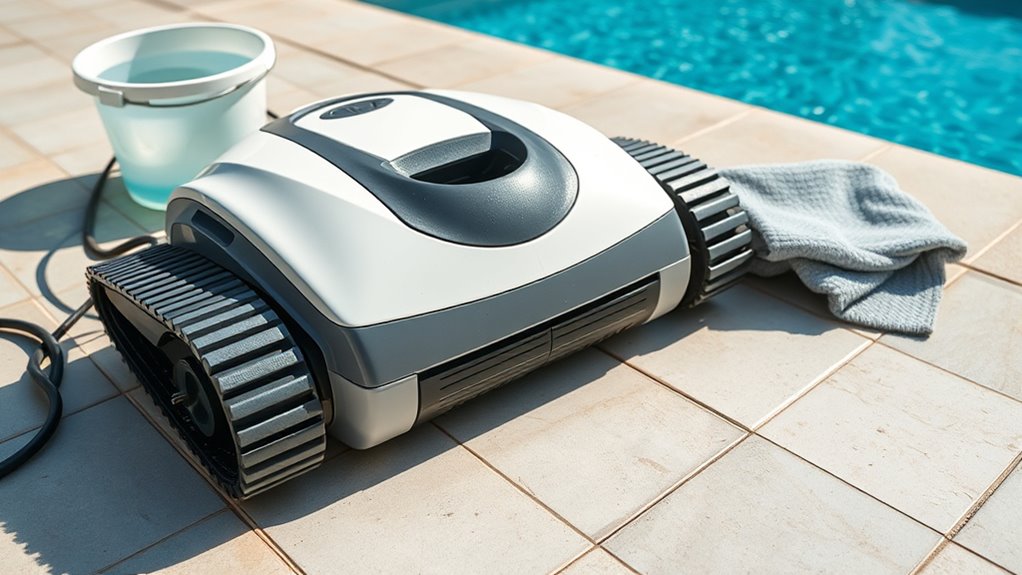
Keeping your robotic pool cleaner in top shape is vital for maintaining a clean and healthy pool. Proper maintenance not only extends its lifespan but also guarantees it works efficiently every time you need it. One of the key aspects of this is regular filter maintenance. After each cleaning session, you should remove the filter and rinse it thoroughly with a garden hose to wash away dirt, debris, and algae. Be sure to check the filter for tears or clogs, replacing it if it’s worn out or damaged. A clean filter allows your robot to suction debris more effectively, reducing strain on its motor and improving overall performance. Additionally, periodically inspect the filter housing for any buildup or obstructions and clean it as needed. This simple step prevents clogs that could hinder the cleaner’s movement or cleaning power. Proper filter maintenance is essential for optimal operation and longevity of your robotic pool cleaner. Regularly cleaning and inspecting filter components can help maintain peak performance and prevent breakdowns.
Battery care is equally vital for guaranteeing your robotic pool cleaner functions at its best. Most models have rechargeable batteries that require proper handling to maximize their lifespan. After each use, always remove the battery if the device allows, or ensure the battery compartment is dry and free of moisture. Avoid leaving the battery in the charger for extended periods once it’s fully charged, as overcharging can diminish battery capacity over time. Store the battery in a cool, dry place when not in use, avoiding extreme temperatures that can degrade its performance. Regularly check the battery for any signs of damage or swelling, and replace it if necessary. Proper battery care ensures your robotic cleaner maintains a strong charge, reducing cleaning times and preventing unexpected failures. Following the manufacturer’s instructions on battery maintenance can help optimize its lifespan.
When it’s time to store your robotic pool cleaner, make sure it’s clean and completely dry. Rinse the entire unit with fresh water to remove residual chlorine, salt, or dirt, which can corrode components over time. Wipe it down with a soft cloth and let it air dry thoroughly before storing. Store the cleaner in a cool, shaded area away from direct sunlight and extreme temperatures, which can cause plastic parts to warp or degrade. If your model has a docking station or charging base, keep it clean and dust-free, and store it in a safe place where it won’t be knocked over or damaged. Proper storage prevents unnecessary wear and tear, ensuring your robotic pool cleaner remains ready for its next use and performs reliably season after season. Regularly inspecting electronic components can help identify early signs of wear or damage, prolonging the device’s lifespan. Additionally, consulting the manufacturer’s guidelines for storage recommendations can further extend your cleaner’s durability.
Frequently Asked Questions
How Often Should I Replace the Robotic Pool Cleaner’S Brushes?
You might wonder about brush replacement and cleaning frequency for your robotic pool cleaner. Typically, you should replace the brushes every six months to ensure peak performance. Regularly check the brushes for wear and tear, especially if cleaning seems less effective. Cleaning the brushes weekly helps prolong their lifespan. Keeping an eye on these aspects ensures your robotic cleaner operates efficiently and lasts longer, saving you time and money.
Can I Use a Pressure Washer to Clean My Robotic Pool Cleaner?
You might wonder if you can use a pressure washer to clean your robotic pool cleaner. While it’s tempting, a pressure washer can be too powerful and may cause water damage to sensitive components. Instead, use a garden hose with moderate pressure to rinse off debris and dirt. This method keeps your cleaner safe, prevents water damage, and ensures it stays in good working condition.
What Should I Do if My Robot Gets Stuck on the Pool’S Steps?
If your robot gets stuck on the pool’s steps, first pause its operation and manually free it. Check its pool step navigation and remove any debris or obstructions that might hinder obstacle avoidance tips. Confirm the robot’s sensors are clean to improve obstacle detection. To prevent future issues, adjust its programming or reposition the steps if possible. Regular maintenance helps your robot navigate smoothly and avoid getting stuck again.
Is It Safe to Store the Robot Outdoors?
Imagine your robotic pool cleaner resting in your backyard, sunlight dappling its surface. While outdoor storage might seem convenient, it’s risky without proper weather protection. Exposure to rain, sun, and humidity can damage its components. To keep it safe, store your robot indoors or in a sheltered area, ensuring it’s protected from the elements. Proper outdoor storage without weather protection can shorten its lifespan and affect performance.
How Do I Troubleshoot Connectivity Issues With the Remote Control?
If you’re experiencing connectivity issues with your robotic pool cleaner’s remote, start with remote troubleshooting by replacing batteries and ensuring there’s a clear line of sight. If problems persist, perform a connectivity reset by turning off both the cleaner and remote, then turning them back on. Keep devices within the recommended range, and avoid interference from other electronics. These steps should help restore a stable connection quickly.
Conclusion
To keep your robotic pool cleaner pristine and performing perfectly, prioritize proper cleaning and storage habits. Regular rinsing, removing debris, and storing it in a cool, dry place prevent pests and problems. Protect your pool partner by practicing these simple steps, ensuring it stays in top shape for trouble-free pool time. Remember, consistent care creates a cleaner, clearer, and more carefree swimming season. Stay diligent, stay delighted, and enjoy your sparkling, sanitized pool all season long.
